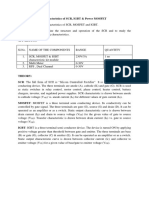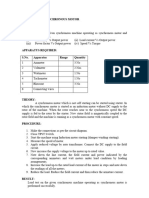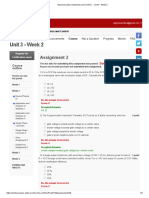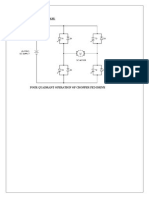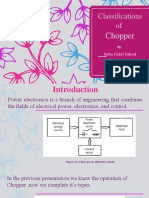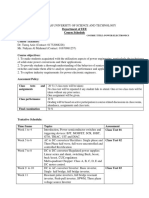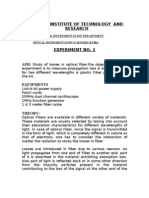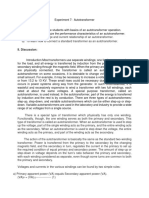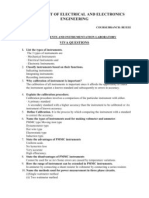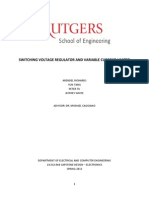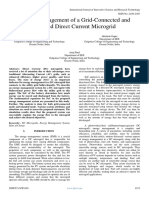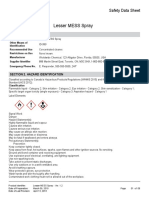Hybrid and Smart Energy Management System Using Arduino
Hybrid and Smart Energy Management System Using Arduino
Volume 9, Issue 5, May – 2024 International Journal of Innovative Science and Research Technology
ISSN No:-2456-2165 https://doi.org/10.38124/ijisrt/IJISRT24MAY721
Hybrid and Smart Energy Management
System using Arduino
Ayush Gautam, Vidhi Shrivastav
Dr. Vinay Kumar
Department of ECE,
GL Bajaj Institute of Technology and Management, Greater Noida
Abstract:- An innovative solution to the ever-increasing system intelligently manages the energy storage of the
efficiency of energy and challenges is presented in the batteries, ensuring that energy is stored. Moreover, this
Smart and Hybrid of Energy Management System using system emphasizes the monitoring and control of load to
Arduino. At the heart of a system is the use of Arduino as increase energy efficiency in the real world. The ability to
a central control unit, offering a cost-effective and flexible dynamically adapt the distribution of the energy for each load
framework for real-time should be monitored and control is a step towards optimized energy consumption, which leads
of energy used. The integration of renewables, with a to cost savings and low impact on the environment. With the
particular focus on photovoltaics, is a very important help of Arduino, users will gain valuable into energy trends
feature of this scheme. To ensure the best possible use of and be able to make informed decisions using real-time data
solar, Arduino controllers have the best role in gathering logging and visualizing capabilities. The system's adaptive
real-time data on Solar Energy Production. At the same control algorithms, which are capable of drastic changes in
time, by monitoring charge and discharging cycles, the the energy demand, supply, and storage conditions, give it a
system effectively manages the storage of batteries. In level of sophistication. The smart and hybrid energy of the
periods of reduced renewable energy production or management system with Arduino is emerging as a beacon for
increased demand, this drastic change in the control innovation in today's complicated energy scene. The system's
mechanism ensures that storage energy is used efficiently. potential to recast energy management paradigms in different
The system shall control and monitor the distribution of contexts is illustrated and sets the stage for an examination of
electricity to each load, to further increase energy it.
efficiency. The system optimizes energy that should be
consumed and reduces both costs and the impact on the II. LITERATURE REVIEW
environment through the adaptation of power supply to
need. The literature review provides a considerable survey of
research and developments in hybrid renewable systems, grid
Keywords:- Nearest level control (NLC), Total harmonic integration, and battery management. In the domain of
distortion (THD), Single switch open fault (SSOF), Multilevel renewable energy, solar stands as a good source, studies show
inverter (MLI), Phase opposition disposition pulse width its potential for wide adoption and grid integration. Research
modulation (POD PWM), ), Symmetric T-type Cross has highlighted the problems connected with the variability
connected source (STTCCS). inherent to solar generation and the critical role of energy
storage in making these issues. Various types of battery
I. INTRODUCTION technologies , range from traditional lead-acid batteries
to more advanced lithium-ion and flow battery systems. the
In the need to sustain an effective use of resources, "a efficiency, performance, and cost-effectiveness of this
smart and hybrid energy management system using Arduino" technology in renewable energy setup, shedding light on their
introduces a revolutionary idea in this area. This system gives suitability for applications and operation situations.
out an innovative solution in the face of increasing energy
demand and a critical need to move towards renewable The evolution of battery management systems (BMS)
sources. The Arduino microcontrollers, which serve as an witnessed many advancements driven by the requirement for
intelligent core that is real-time monitored and controlled, are better and adaptive control solutions. In old BMS primarily
central to its functionality. This system provides a dynamic focused on basic things such as voltage monitor and
and flexible framework for efficiency of energy optimization, overcharge protection. However, the advent of smart BMS
responding to the problems of traditional energy management solutions in a new era of energy manages by real-time
methods. It adopts a cost-effective and flexible approach to monitoring, analytics, and grid interaction capabilities. These
align with the growing trend of the IoT in smart systems smart BMS systems leverage control algorithms to energy
through the integration of the smart system of work Arduino utilization, extend battery span, and make better grid stability.
microcontrollers. Integration of renewable energy, in Solar While existing literature says the potential of smart BMS in
panels is the of this system. By taking and analyzing real-time improving energy efficiency and reliability, challenges such
energy production data, Arduino controllers play an important as scalable, interoperable, and necessary further innovation
role in ensuring the best use of solar power. At the same, the and research in the work.
IJISRT24MAY721 www.ijisrt.com 1478
Volume 9, Issue 5, May – 2024 International Journal of Innovative Science and Research Technology
ISSN No:-2456-2165 https://doi.org/10.38124/ijisrt/IJISRT24MAY721
Moreover, the hybrid of renewable energy sources with A. System Architecture:
the grid introduces additional and more opportunities. Studies The Smart Hybrid Battery Management System is
have explored various grid strategies, including grid-tied and developed to provide the linchpin in solar-to-battery and grid
off-grid systems, microgrid deployed, and demand-side setups. It is made up of Arduino board microcontrollers for
management techniques. Grid systems allow for a bi- real-time monitoring and controlling, sensors for data
directional flow of power between renewable sources energy, making, switch relays between solar panels, batteries ensured
battery, and the grid, enabling more energy to be exported or by the modular architecture, and grid energy sources, all the
imported depending on demand and need of signals. In communication models that communicate with each other.
contrast, off-grid and microgrid and resilience, cater to Flexibility, scale, and interoperability with the existing
isolated communities and hard infrastructure. In addition, infrastructure.
demand-side management techniques such as load shift, and
peak shaving have been investigated to optimize energy
consumption and give stress on the grid during peak demand
periods.
Fig 1: Flowchart
B. Functionality: Intelligent control: Arduino kept sophisticated
The function of the Smart Hybrid Battery management algorithms to optimize discharge and charging processes,
system spans many domains including: giving importance to energy sources, and ensuring a
seamless grid to integrate.
Real-time monitoring: Sensors monitor parameters such Grid integration:
as battery voltage, battery, temperature, and solar Communication of the modules allows interoperability
irradiance. within the grid, allowing the exchange of power and
demand main to get the functions implemented.
IJISRT24MAY721 www.ijisrt.com 1479
Volume 9, Issue 5, May – 2024 International Journal of Innovative Science and Research Technology
ISSN No:-2456-2165 https://doi.org/10.38124/ijisrt/IJISRT24MAY721
Fig 2: Smart Hybrid Energy Management System using Arduino
C. Implementation: programming of the Arduino environment is being harnessed
Assembly of hardware and sensor calibration, to develop the firmware custom-tailored to the requirement of
development of firmware, and integration of the system solar panel to battery and then to grid integration scene.
should be part of the establishing stage. Versatile
Fig 3: Implementation
IJISRT24MAY721 www.ijisrt.com 1480
Volume 9, Issue 5, May – 2024 International Journal of Innovative Science and Research Technology
ISSN No:-2456-2165 https://doi.org/10.38124/ijisrt/IJISRT24MAY721
D. Performance Evaluation: [7]. Haji-Esmaeili, M. M., Naseri, M., Khoun-Jahan,
Testing in the real world and the study of simulation are H., & Aba pour, M. (2017). Fault-tolerant
taken out rigidly to assess the performance of Smart and structure for cascaded h-bridge multilevel
Hybrid battery management systems. To verify the presence inverter and reliability evaluation. IET Power
of the given solution, important performance metrics are grid Electronics, 10(1), 59–70.
stability of energy and enhancement of efficiency, and the [8]. Saadian & Hosseini S.M. (2017). Cascaded
response time should be calculated from different multilevel inverter based on symmetric-
perspectives of operational conditions. asymmetric DC sources with fewer components.
IET Power Electronics, 10(12), 1468–1478.
III. CONCLUSION [9]. Axelrod, B., Berkovich, Y., & Voinovich, A.
(2003). Fault Tolerant H-Bridge for New Circuit
In conclusion, an important step towards realizing the Topology. Proceedings in the year of 2003 an
full efficiency of a hybrid system of renewable systems is International conference on System and Circuits,
taken with the implementation and development of an in 2003. ISCAS ’03., 3(6), 1509–1516.
intelligent BMS. This solution set the stage for the sustainable
production of energy, grid, and energy independence through
the seamless integration of solar with the battery and
networks. To improve system scale interoperability and
efficiency further research and development efforts are
granted.
FUTURE DIRECTION
Future research efforts should be on improving BMS
intelligence by developing the edge cutting of learning
machine algorithms researching new energy-storing
technology and expanding the grid interaction and
functionalities. It would be easy for the widespread
integration and adaptation of BMS into energy infrastructure.
If efforts are made to interoperability standards and
harmonize protocols, then it becomes easier to establish
things adequately.
REFERENCES
[1]. M.H. Rashid, Power Electronics Circuits, and the
Devices and Applications, India: Pearson
Education Inc.,2004.
[2]. Gupta, K. K., Ranjan, A., Bhatnagar, P., Sahu, L.
K., & Jain, S. (2016). Multilevel inverter
topology with the reduced device of count: A
review. IEEE Transactions on Power Electronics,
31(1), 135–151.
[3]. Gupta, K. K., & Jain, S. (2014). A multilevel
inverter based on switched DC sources. IEEE
Transactions on the Industrial Electronics, 61(7),
3269–3278.
[4]. Agrawal, R., & Jain, S. (2017). IET Renewable
Power can be Generated. 11(14), 1822–1831.
[5]. A, M. R., & Sivakumar, K. (2015). A Fault-
Tolerant Single-Phase Five-Level Fault-Tolerant
Single-Phase Inverter for Grid-Independent PV
Systems. IEEE Transaction of the Industry
Electronics, 62(12), 7569– 7577.
[6]. Chen, A., Hu, L., Chen, L., Deng, Y., Yao, G., &
He, X. (2004). A fault-tolerant ability. Conference
for the Proceedings of Multilevel Converter
Topology. – IEEE APPLIED POWER
ELECTRONICS CONFERENCE- APEC, 3(2),
1610–1616.
IJISRT24MAY721 www.ijisrt.com 1481
You might also like
- Experiment No. 5 Diode Approximation: Abstract - Bridges Are Unarguably One Key Components of TheNo ratings yetExperiment No. 5 Diode Approximation: Abstract - Bridges Are Unarguably One Key Components of The3 pages
- Load Test On 3 o Squirrel Cage Induction MotorNo ratings yetLoad Test On 3 o Squirrel Cage Induction Motor4 pages
- MATLAB SIMULINK File Power Electronic Ci PDFNo ratings yetMATLAB SIMULINK File Power Electronic Ci PDF29 pages
- Automatic Water Level Controller: Deepti Rawat, Dinesh Kumar Yadav, S.K. MahajanNo ratings yetAutomatic Water Level Controller: Deepti Rawat, Dinesh Kumar Yadav, S.K. Mahajan4 pages
- Experiment: AIM: Study D.C Position Control SystemNo ratings yetExperiment: AIM: Study D.C Position Control System23 pages
- P.F. & P.F Improvement of Using CapacitorNo ratings yetP.F. & P.F Improvement of Using Capacitor3 pages
- ENA Lab 9 Balanced Three-Phase Circuit (Software)No ratings yetENA Lab 9 Balanced Three-Phase Circuit (Software)12 pages
- Power Electronics Lab Experiment-No. 6 Single-Phase Full and Half Wave Controlled SCR Rectifier Aim: To Study and Analyze The Properties and The Characteristics of A Single-PhaseNo ratings yetPower Electronics Lab Experiment-No. 6 Single-Phase Full and Half Wave Controlled SCR Rectifier Aim: To Study and Analyze The Properties and The Characteristics of A Single-Phase6 pages
- Experiment 12 The Universal Motor ObjectiveNo ratings yetExperiment 12 The Universal Motor Objective5 pages
- High Voltage Engineering Lecture Notes: G.Kranthi KumarNo ratings yetHigh Voltage Engineering Lecture Notes: G.Kranthi Kumar46 pages
- Non-Linear Wave Shaping Circuits Clippers AIMNo ratings yetNon-Linear Wave Shaping Circuits Clippers AIM5 pages
- Measurement of Reactive Power of Star and Delta Connected Balanced Loads0% (1)Measurement of Reactive Power of Star and Delta Connected Balanced Loads3 pages
- Mains Over Voltage and Under Voltage Protection Circuit100% (1)Mains Over Voltage and Under Voltage Protection Circuit15 pages
- Experiment # 09: Objective: To Study The Over Voltage Protection of DC Power Supply System (CLO 1) Apparatus100% (1)Experiment # 09: Objective: To Study The Over Voltage Protection of DC Power Supply System (CLO 1) Apparatus20 pages
- Advance Power Electronics and Control - Unit 3 - Week 2No ratings yetAdvance Power Electronics and Control - Unit 3 - Week 24 pages
- 1918779744-Measurement of Earth Resistance Using MeggerNo ratings yet1918779744-Measurement of Earth Resistance Using Megger3 pages
- Obstacle Detector: Name Roll No Name Roll No Name Roll No Name Roll No100% (2)Obstacle Detector: Name Roll No Name Roll No Name Roll No Name Roll No10 pages
- JNTUA Basic Electrical & Electronics Engineering - PPT Notes - R20No ratings yetJNTUA Basic Electrical & Electronics Engineering - PPT Notes - R20123 pages
- Magnetic Amplifier in Series: Operation ManualNo ratings yetMagnetic Amplifier in Series: Operation Manual6 pages
- Classifications of Chopper (Suha Dalaf)No ratings yetClassifications of Chopper (Suha Dalaf)28 pages
- Singly-Excited and Doubly Excited SystemsNo ratings yetSingly-Excited and Doubly Excited Systems4 pages
- Measurement and Instrumentation Lab ManualNo ratings yetMeasurement and Instrumentation Lab Manual3 pages
- To Determine The Voltage Regulation With Resistive, Inductive and Capacitive Loading of A TransformerNo ratings yetTo Determine The Voltage Regulation With Resistive, Inductive and Capacitive Loading of A Transformer3 pages
- "Bridge B2HZ" For The Control of A DC MotorNo ratings yet"Bridge B2HZ" For The Control of A DC Motor16 pages
- Energy Management of A Grid-Connected and Islanded Direct Current MicrogridNo ratings yetEnergy Management of A Grid-Connected and Islanded Direct Current Microgrid6 pages
- A Review of Renewable Energy Systems For Industrial ApplicationsNo ratings yetA Review of Renewable Energy Systems For Industrial Applications8 pages
- AI Applications in The Renewable Energy SectorNo ratings yetAI Applications in The Renewable Energy Sector4 pages
- Epistemic Risks of Big Data Analytics in Scientific Discovery: Analysis of the Reliability and Biases of Inductive Reasoning in Large-Scale DatasetsNo ratings yetEpistemic Risks of Big Data Analytics in Scientific Discovery: Analysis of the Reliability and Biases of Inductive Reasoning in Large-Scale Datasets7 pages
- The Digital Influence ChatGPT and its Role in Shaping Youth Cognitive Processes and Decision-MakingNo ratings yetThe Digital Influence ChatGPT and its Role in Shaping Youth Cognitive Processes and Decision-Making5 pages
- To Compare the Effectiveness of Jacobson’s Relaxation Techniques and Mitchell’s Relaxation Techniques along with Diaphragmatic Breathing on Insomnia in Elderly IndividualsNo ratings yetTo Compare the Effectiveness of Jacobson’s Relaxation Techniques and Mitchell’s Relaxation Techniques along with Diaphragmatic Breathing on Insomnia in Elderly Individuals9 pages
- Influence of Age, Gender, Socioeconomic Status, and Education Level on Glycemic Control in Diabetic Patients Attending Kapkatet Sub-County Hospital, Kericho County, KenyaNo ratings yetInfluence of Age, Gender, Socioeconomic Status, and Education Level on Glycemic Control in Diabetic Patients Attending Kapkatet Sub-County Hospital, Kericho County, Kenya9 pages
- Bridging the Digital Divide in Agriculture: Lessons from the United States and Africa in Smart Farming AdoptionNo ratings yetBridging the Digital Divide in Agriculture: Lessons from the United States and Africa in Smart Farming Adoption10 pages
- A Comparative Analysis of Natural Language Processing Models: BERT and LSTM in Enhancing Business CommunicationNo ratings yetA Comparative Analysis of Natural Language Processing Models: BERT and LSTM in Enhancing Business Communication6 pages
- From Visualization to Purchase: How Augmented Reality (AR), Virtual Reality (VR) and Artificial Intelligence (AI) Influence Consumer Purchase Decisions in Housing Design DecisionsNo ratings yetFrom Visualization to Purchase: How Augmented Reality (AR), Virtual Reality (VR) and Artificial Intelligence (AI) Influence Consumer Purchase Decisions in Housing Design Decisions23 pages
- Case Study and Examination of Production Methods in a Steel Manufacturing FacilityNo ratings yetCase Study and Examination of Production Methods in a Steel Manufacturing Facility7 pages
- Impact of Storytelling and Emotional Branding on Consumer Purchase Behavior in Quick Service Restaurants and FMCGNo ratings yetImpact of Storytelling and Emotional Branding on Consumer Purchase Behavior in Quick Service Restaurants and FMCG15 pages
- Comparing the Effect of Ashoka Ointment and Herjet OintmentNo ratings yetComparing the Effect of Ashoka Ointment and Herjet Ointment5 pages
- AI-Driven Predictive Analytics for Syndromic Surveillance: Enhancing Early Detection of Emerging Infectious Diseases in the United StatesNo ratings yetAI-Driven Predictive Analytics for Syndromic Surveillance: Enhancing Early Detection of Emerging Infectious Diseases in the United States8 pages
- Geriatric Medication Management Using STOPP/START Criteria on Polypharmacy in a Multicentre Hospital: A Systematic ReviewNo ratings yetGeriatric Medication Management Using STOPP/START Criteria on Polypharmacy in a Multicentre Hospital: A Systematic Review6 pages
- Remarkable Spatial Influences behind Shaping the Bangla Dance: Performer and Audience PerspectivesNo ratings yetRemarkable Spatial Influences behind Shaping the Bangla Dance: Performer and Audience Perspectives8 pages
- Psychological Well-being among Tribal and Non-Tribal B.Ed. StudentsNo ratings yetPsychological Well-being among Tribal and Non-Tribal B.Ed. Students4 pages
- Affirmative Policy on Belis in Marriage Traditions at Family Institutions in the Abenaho District of PapuaNo ratings yetAffirmative Policy on Belis in Marriage Traditions at Family Institutions in the Abenaho District of Papua14 pages
- Synergizing Renewables with Power Grid: A Path towards Stability and SustainabilityNo ratings yetSynergizing Renewables with Power Grid: A Path towards Stability and Sustainability5 pages
- Library Personnel’s Career Development and Job Performance of the National UniversityNo ratings yetLibrary Personnel’s Career Development and Job Performance of the National University8 pages
- Autonomous Obstacle Avoiding and Pesticide Spraying Robot for Smart FarmingNo ratings yetAutonomous Obstacle Avoiding and Pesticide Spraying Robot for Smart Farming4 pages
- Factors Influencing the Organizational Performance of Hotel EstablishmentsNo ratings yetFactors Influencing the Organizational Performance of Hotel Establishments12 pages
- An Integrated Web Application for Campus Life: A Digital Solution for Learning and VotingNo ratings yetAn Integrated Web Application for Campus Life: A Digital Solution for Learning and Voting8 pages
- Structural Equation Modeling of Students’ Performance in Pre-Calculus: Basis for Intervention in Senior High School100% (1)Structural Equation Modeling of Students’ Performance in Pre-Calculus: Basis for Intervention in Senior High School12 pages
- Citizen Satisfaction with Electronic-Government Services: A Case Study of Huduma Centre MombasaNo ratings yetCitizen Satisfaction with Electronic-Government Services: A Case Study of Huduma Centre Mombasa13 pages
- Leveraging Digital Surveillance Technologies for Managing Border Porosity and Enhancing Revenue Collection in KenyaNo ratings yetLeveraging Digital Surveillance Technologies for Managing Border Porosity and Enhancing Revenue Collection in Kenya11 pages
- Leveraging Wi-Fi-Based Tracking for Enhanced Conference Management and Exhibitor ValueNo ratings yetLeveraging Wi-Fi-Based Tracking for Enhanced Conference Management and Exhibitor Value11 pages
- Precision, Prediction and Progress: A New Era in PharmacologyNo ratings yetPrecision, Prediction and Progress: A New Era in Pharmacology23 pages
- Chinh phục 80 đề tiếng anh vào 10 năm 2023 Bùi Văn Vinh PRACTICE TEST 9No ratings yetChinh phục 80 đề tiếng anh vào 10 năm 2023 Bùi Văn Vinh PRACTICE TEST 95 pages
- Plumbing Terminologies With Illustrations (From An American Plumbing Code)No ratings yetPlumbing Terminologies With Illustrations (From An American Plumbing Code)52 pages
- Word Formation: Edited By: Tran Truong Thanh0% (1)Word Formation: Edited By: Tran Truong Thanh11 pages
- FINAL TEMPLATE City of Sydney 2019 Energy Audit ProposalNo ratings yetFINAL TEMPLATE City of Sydney 2019 Energy Audit Proposal5 pages
- Chapter One: Preliminary Design of Railway LineNo ratings yetChapter One: Preliminary Design of Railway Line7 pages
- RevisionWS - HYE - VII - Geo - Ch.3 CH 5 and Ch.7 - 2024-25No ratings yetRevisionWS - HYE - VII - Geo - Ch.3 CH 5 and Ch.7 - 2024-256 pages
- Delete The Sentences Colored in RED: Prelim Exam / Hydrology Page 1 of 2No ratings yetDelete The Sentences Colored in RED: Prelim Exam / Hydrology Page 1 of 29 pages
- BEM 4101 - Introduction To Environmental Dibel - SUBMITEDNo ratings yetBEM 4101 - Introduction To Environmental Dibel - SUBMITED11 pages
- Behavior Approach For Designing in ArchitectureNo ratings yetBehavior Approach For Designing in Architecture5 pages
- PDF Handbook of Environmental Impact Assessment 1st Edition Alberto Fonseca Download100% (18)PDF Handbook of Environmental Impact Assessment 1st Edition Alberto Fonseca Download84 pages
- Experiment No. 5 Diode Approximation: Abstract - Bridges Are Unarguably One Key Components of TheExperiment No. 5 Diode Approximation: Abstract - Bridges Are Unarguably One Key Components of The
- Automatic Water Level Controller: Deepti Rawat, Dinesh Kumar Yadav, S.K. MahajanAutomatic Water Level Controller: Deepti Rawat, Dinesh Kumar Yadav, S.K. Mahajan
- Experiment: AIM: Study D.C Position Control SystemExperiment: AIM: Study D.C Position Control System
- Power Electronics Lab Experiment-No. 6 Single-Phase Full and Half Wave Controlled SCR Rectifier Aim: To Study and Analyze The Properties and The Characteristics of A Single-PhasePower Electronics Lab Experiment-No. 6 Single-Phase Full and Half Wave Controlled SCR Rectifier Aim: To Study and Analyze The Properties and The Characteristics of A Single-Phase
- High Voltage Engineering Lecture Notes: G.Kranthi KumarHigh Voltage Engineering Lecture Notes: G.Kranthi Kumar
- Measurement of Reactive Power of Star and Delta Connected Balanced LoadsMeasurement of Reactive Power of Star and Delta Connected Balanced Loads
- Mains Over Voltage and Under Voltage Protection CircuitMains Over Voltage and Under Voltage Protection Circuit
- Experiment # 09: Objective: To Study The Over Voltage Protection of DC Power Supply System (CLO 1) ApparatusExperiment # 09: Objective: To Study The Over Voltage Protection of DC Power Supply System (CLO 1) Apparatus
- Advance Power Electronics and Control - Unit 3 - Week 2Advance Power Electronics and Control - Unit 3 - Week 2
- 1918779744-Measurement of Earth Resistance Using Megger1918779744-Measurement of Earth Resistance Using Megger
- Obstacle Detector: Name Roll No Name Roll No Name Roll No Name Roll NoObstacle Detector: Name Roll No Name Roll No Name Roll No Name Roll No
- JNTUA Basic Electrical & Electronics Engineering - PPT Notes - R20JNTUA Basic Electrical & Electronics Engineering - PPT Notes - R20
- To Determine The Voltage Regulation With Resistive, Inductive and Capacitive Loading of A TransformerTo Determine The Voltage Regulation With Resistive, Inductive and Capacitive Loading of A Transformer
- Computer Aided Design of Electrical MachinesFrom EverandComputer Aided Design of Electrical Machines
- Energy Management of A Grid-Connected and Islanded Direct Current MicrogridEnergy Management of A Grid-Connected and Islanded Direct Current Microgrid
- A Review of Renewable Energy Systems For Industrial ApplicationsA Review of Renewable Energy Systems For Industrial Applications
- Epistemic Risks of Big Data Analytics in Scientific Discovery: Analysis of the Reliability and Biases of Inductive Reasoning in Large-Scale DatasetsEpistemic Risks of Big Data Analytics in Scientific Discovery: Analysis of the Reliability and Biases of Inductive Reasoning in Large-Scale Datasets
- The Digital Influence ChatGPT and its Role in Shaping Youth Cognitive Processes and Decision-MakingThe Digital Influence ChatGPT and its Role in Shaping Youth Cognitive Processes and Decision-Making
- To Compare the Effectiveness of Jacobson’s Relaxation Techniques and Mitchell’s Relaxation Techniques along with Diaphragmatic Breathing on Insomnia in Elderly IndividualsTo Compare the Effectiveness of Jacobson’s Relaxation Techniques and Mitchell’s Relaxation Techniques along with Diaphragmatic Breathing on Insomnia in Elderly Individuals
- Influence of Age, Gender, Socioeconomic Status, and Education Level on Glycemic Control in Diabetic Patients Attending Kapkatet Sub-County Hospital, Kericho County, KenyaInfluence of Age, Gender, Socioeconomic Status, and Education Level on Glycemic Control in Diabetic Patients Attending Kapkatet Sub-County Hospital, Kericho County, Kenya
- Bridging the Digital Divide in Agriculture: Lessons from the United States and Africa in Smart Farming AdoptionBridging the Digital Divide in Agriculture: Lessons from the United States and Africa in Smart Farming Adoption
- A Comparative Analysis of Natural Language Processing Models: BERT and LSTM in Enhancing Business CommunicationA Comparative Analysis of Natural Language Processing Models: BERT and LSTM in Enhancing Business Communication
- From Visualization to Purchase: How Augmented Reality (AR), Virtual Reality (VR) and Artificial Intelligence (AI) Influence Consumer Purchase Decisions in Housing Design DecisionsFrom Visualization to Purchase: How Augmented Reality (AR), Virtual Reality (VR) and Artificial Intelligence (AI) Influence Consumer Purchase Decisions in Housing Design Decisions
- Case Study and Examination of Production Methods in a Steel Manufacturing FacilityCase Study and Examination of Production Methods in a Steel Manufacturing Facility
- Impact of Storytelling and Emotional Branding on Consumer Purchase Behavior in Quick Service Restaurants and FMCGImpact of Storytelling and Emotional Branding on Consumer Purchase Behavior in Quick Service Restaurants and FMCG
- Comparing the Effect of Ashoka Ointment and Herjet OintmentComparing the Effect of Ashoka Ointment and Herjet Ointment
- AI-Driven Predictive Analytics for Syndromic Surveillance: Enhancing Early Detection of Emerging Infectious Diseases in the United StatesAI-Driven Predictive Analytics for Syndromic Surveillance: Enhancing Early Detection of Emerging Infectious Diseases in the United States
- Geriatric Medication Management Using STOPP/START Criteria on Polypharmacy in a Multicentre Hospital: A Systematic ReviewGeriatric Medication Management Using STOPP/START Criteria on Polypharmacy in a Multicentre Hospital: A Systematic Review
- Remarkable Spatial Influences behind Shaping the Bangla Dance: Performer and Audience PerspectivesRemarkable Spatial Influences behind Shaping the Bangla Dance: Performer and Audience Perspectives
- Psychological Well-being among Tribal and Non-Tribal B.Ed. StudentsPsychological Well-being among Tribal and Non-Tribal B.Ed. Students
- Affirmative Policy on Belis in Marriage Traditions at Family Institutions in the Abenaho District of PapuaAffirmative Policy on Belis in Marriage Traditions at Family Institutions in the Abenaho District of Papua
- Synergizing Renewables with Power Grid: A Path towards Stability and SustainabilitySynergizing Renewables with Power Grid: A Path towards Stability and Sustainability
- Library Personnel’s Career Development and Job Performance of the National UniversityLibrary Personnel’s Career Development and Job Performance of the National University
- Autonomous Obstacle Avoiding and Pesticide Spraying Robot for Smart FarmingAutonomous Obstacle Avoiding and Pesticide Spraying Robot for Smart Farming
- Factors Influencing the Organizational Performance of Hotel EstablishmentsFactors Influencing the Organizational Performance of Hotel Establishments
- An Integrated Web Application for Campus Life: A Digital Solution for Learning and VotingAn Integrated Web Application for Campus Life: A Digital Solution for Learning and Voting
- Structural Equation Modeling of Students’ Performance in Pre-Calculus: Basis for Intervention in Senior High SchoolStructural Equation Modeling of Students’ Performance in Pre-Calculus: Basis for Intervention in Senior High School
- Citizen Satisfaction with Electronic-Government Services: A Case Study of Huduma Centre MombasaCitizen Satisfaction with Electronic-Government Services: A Case Study of Huduma Centre Mombasa
- Leveraging Digital Surveillance Technologies for Managing Border Porosity and Enhancing Revenue Collection in KenyaLeveraging Digital Surveillance Technologies for Managing Border Porosity and Enhancing Revenue Collection in Kenya
- Leveraging Wi-Fi-Based Tracking for Enhanced Conference Management and Exhibitor ValueLeveraging Wi-Fi-Based Tracking for Enhanced Conference Management and Exhibitor Value
- Precision, Prediction and Progress: A New Era in PharmacologyPrecision, Prediction and Progress: A New Era in Pharmacology
- Chinh phục 80 đề tiếng anh vào 10 năm 2023 Bùi Văn Vinh PRACTICE TEST 9Chinh phục 80 đề tiếng anh vào 10 năm 2023 Bùi Văn Vinh PRACTICE TEST 9
- Plumbing Terminologies With Illustrations (From An American Plumbing Code)Plumbing Terminologies With Illustrations (From An American Plumbing Code)
- FINAL TEMPLATE City of Sydney 2019 Energy Audit ProposalFINAL TEMPLATE City of Sydney 2019 Energy Audit Proposal
- RevisionWS - HYE - VII - Geo - Ch.3 CH 5 and Ch.7 - 2024-25RevisionWS - HYE - VII - Geo - Ch.3 CH 5 and Ch.7 - 2024-25
- Delete The Sentences Colored in RED: Prelim Exam / Hydrology Page 1 of 2Delete The Sentences Colored in RED: Prelim Exam / Hydrology Page 1 of 2
- BEM 4101 - Introduction To Environmental Dibel - SUBMITEDBEM 4101 - Introduction To Environmental Dibel - SUBMITED
- PDF Handbook of Environmental Impact Assessment 1st Edition Alberto Fonseca DownloadPDF Handbook of Environmental Impact Assessment 1st Edition Alberto Fonseca Download








